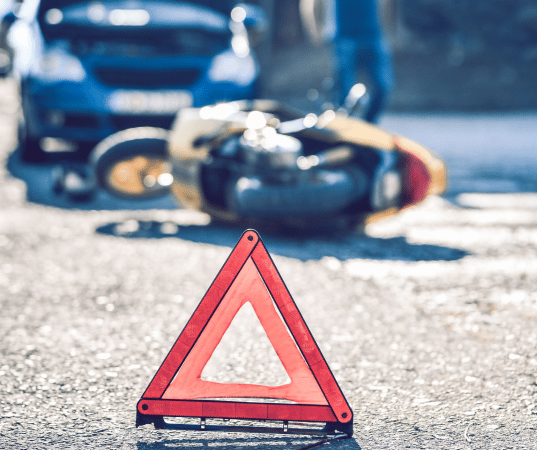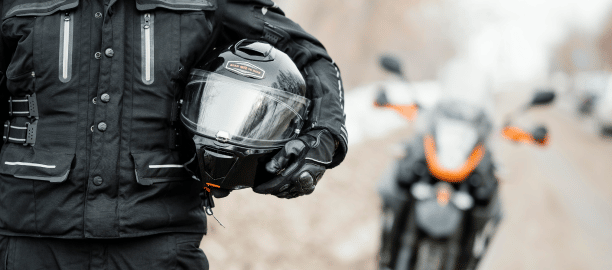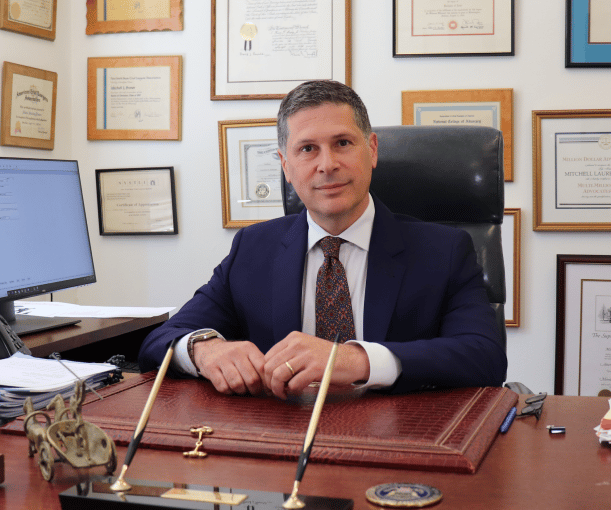Save a Life: Campaign for Motorcycle Safety
The Motorcycle Safety Fact Sheet by the National Highway Traffic Safety Administration (NHTSA) revealed that motorcyclists are nearly 28 times more likely than automobile occupants to die in a traffic crash.
The 2020 Motorcycle Safety Fact Sheet by the National Highway Traffic Safety Administration (NHTSA) revealed that motorcyclists are nearly 28 times more likely than automobile occupants to die in a traffic crash.
Due the nature of being more exposed and less visible to other vehicles on the road, motorcycle accidents can result in more serious injuries for riders. That is why it’s important for not only motorcycle riders to be aware of ways to increase their safety on the road, but also for car drivers to be know how to avoid motorcycle accidents as well.
Motorcycle Crash Stats
According to Ultimate Motorcycling, more than 8 percent of U.S. households owned a motorcycle as of 2018, an increase of approximately 1.5 million households since 2014. These numbers have been increasing for decades, and there is no indication this trend will change anytime soon.
Even with this increase in ownership, motorcycles represent just 3 percent of registered vehicles on the roadways and 0.6 percent of vehicle miles traveled in the United States, according to the National Security Council. Yet motorcycle accidents accounted for approximately 14 percent of all fatal traffic accidents and 18 percent of occupant fatalities in 2020.
This is an 11 percent increase in the number of riders and passenger fatalities since 2019. Over the last ten years, the death rate has increased by 27 percent.
These increases could be attributed, at least in part, to the increase in motorcycle riders, and it underscores the importance of safety awareness.
According to the NHTSA, an estimated 82,528 motorcyclists were injured in traffic accidents in 2020, and 5,579 were killed. This is the highest number of fatalities in a single year since the Fatality Analysis Reporting System (FARS) began in 1975.
Demographics
The demographics of motorcycle ownership are changing:
According to the Insurance Institute of Highway Safety (IIHS), the average age of registered motorcycle owners has increased from 27 in 1980 to 50 in 2018.
The IIHS has also found that an increasing number of women own motorcycles.
- In 1990, only 6 percent of motorcycle riders were women.
- By 2018, this number had increased to 19 percent.
Ultimate Motorcycling has found that the number of college graduates who own motorcycles is gradually increasing, having reached 24 percent by 2018.
Ultimate Motorcycling also reports that motorcycle ownership is trending among millennials.
- Over half have taken safety courses.
- They frequently use their motorcycles for commuting.
- 69 percent are interested in electric motorcycles for their fuel economy and reduced impact on the environment compared to motor vehicles.
The age groups with the highest numbers of fatalities in 2020:
- 25–29: 706 fatalities
- 30–34: 690 fatalities
- 65+: 530 fatalities
- 55–59: 529 fatalities
- 50–54: 506 fatalities
- 21–24: 506 fatalities
While the increase in the average age of ownership shows some correlation with the number of older riders involved in fatal crashes, this does not hold true for the increase in female riders.

Fatal Crashes Involving Older Riders
In 1982, approximately 3 percent of fatally injured motorcyclists were over 50. Today, motorcycle fatalities in the over 50 group account for more than a third of motorcycle fatalities. According to the NHTSA, the percentage of motorcyclists killed in crashes who were 55 or older increased from 23 percent in 2011 to 27 percent in 2020.
The average age of a motorcycle fatality in 2020 was 43, up from 42 in 2011.
Fatal Crashes Involving Women
Only 3 percent of fatally injured motorcyclists in 2020 were women, despite women’s increase in ridership. However, 92 percent of fatally injured motorcycle passengers were women.
A ScienceDirect analysis of the injury patterns in men and women who had been hospitalized after motorcycle crashes revealed that women were less likely to be admitted to ICU and more likely to survive. Women’s injuries tended to be to the extremities, while men were more likely to experience head, neck, and thorax injuries.
Most Common Causes of Motorcycle Accidents
Human error is responsible for virtually all accidents, which is why automobile drivers present the most significant hazards to motorcyclists.
How do most motorcycle accidents occur?
The motorcycle rider is not always at fault in accidents, but certain behaviors can increase a rider’s chances of experiencing a crash.
Left Turns by Car Drivers
Data compiled by the NHTSA revealed that as many as 42 percent of fatal motorcycle crashes occurred when vehicle drivers turned left in front of motorcycles that were going straight. These accidents most often occur because the driver failed to see the motorcyclists. The NHTSA identified 70,223 of these types of crashes during the period from 2011 to 2014.
Numerous studies have uncovered that this inattentional blindness, also known as looked-but-failed-to-see (LBFTS), is a universal issue with a scientific explanation: Due to the high level of sensory input during driving, the brain prioritizes what it processes.
For whatever reason, the brain filters out motorcycles, preventing the driver from seeing them even while looking right at them. The NHTSA identified 52,078 instances of LBFTS in its analysis of motorcycle-vehicle crashes involving both injury and death from 2011 to 2014.
Distracted Drivers
Distracted driving occurs when the driver’s focus is diverted from driving, even for a short time. Distracting activities include eating, playing with the radio, talking on a cell phone (even hands-free), texting, and reading text messages. Distracted drivers are a danger to every road user, especially vulnerable users such as pedestrians, bicyclists, and motorcyclists.
According to the NHTSA, distracted drivers killed 3,142 people and injured 324,652 more in 2020 alone. The NHTSA identified 31,992 total injury and fatal motorcycle crashes caused by distracted drivers from 2011 to 2014.
Sudden or Unexpected Driver Behaviors
Many merely annoying behaviors to vehicle drivers are dangerous for motorcyclists. Even a slight fender bender that barely impacts a passenger car can be deadly for a motorcycle rider. The following driver behaviors are a serious threat to motorcyclists:
- Sudden stops
- Vehicle overshadowing
- Lane changing into the motorcycle’s lane
- Unexpected car doors opening
- Hidden driveways
- Driver failure to yield
Some of these behaviors occur as a result of motor vehicle drivers failing to see motorcycles, which have a smaller, narrower profile. In addition to LBFTS, the following factors can prevent motorists from seeing motorcycles:
- Glare
- Blind spots on the vehicle
- Failing to pay attention at intersections
- Erroneous mirror positioning
- Lack of environmental awareness: since motorcyclists frequently use their transmissions rather than their brakes to slow down, brake lights are not activated, and inattentive drivers fail to notice the slowdown
Tips for Car Drivers (Not on Motorcycles)
Car drivers owe motorcycle riders a duty of care while on the roadways. Automobiles are larger and heavier than motorcycles, and their potential to cause riders serious harm is significant. The following tips will help drivers share the road safely with motorcyclists.

Address your biases
Motorcyclists have the same rights to use the roadways as drivers, and their choice to ride motorcycles does not make them any more deserving of a devastating accident than your decision to drive a car.
Check your blind spots
Be aware of where your blind spots are. When turning, backing, or switching lanes:
- Use your rearview and side mirrors.
- Look over your shoulder.
Use your turn signals
A simple turn signal can save a motorcycle rider’s life by preventing the motorcyclist from trying to pass you before you complete your turn or lane change.
Pay attention to speed
You may not see motorcycle brake lights when they are slowing down. Stay alert and remain conscious of the distance between your vehicle and the motorcycle.
Give the motorcycle plenty of space
Leave well over three to four seconds between your vehicle and the motorcycle. Allow the motorcycle the full lane width, and leave plenty of space when turning around a motorcycle or passing one.
Yield to motorcycles at intersections
It can be difficult to judge a motorcycle’s distance and speed. Play it safe and wait.
Observe all traffic laws
Abide by the posted speed limits, and obey traffic control devices.
Drive sober
Remember that any amount of drugs or alcohol can impair your judgment and slow your reaction time.
Drive defensively
Always be ready for the motorcycle or other drivers to do the wrong thing.
Be aware of non-canceling turn signals
Motorcycle turn signals are not always self-canceling, so be aware that a motorcycle’s blinker does not always signal an impending turn.
Be alert for motorcycles
Avoid distractions, and make a habit of taking an extra second to consciously check for motorcycles before proceeding at any intersection or switching lanes.
- This can eliminate LBFTS.
- This can provide an opportunity to see a motorcycle that may be obscured by a larger vehicle.
Assume a motorcycle is closer than it appears
The smaller size and narrow profile of a motorcycle can make it appear to be farther away than it is.
Be aware of stopping distance
Contrary to popular belief, motorcycles cannot necessarily stop faster than cars, especially in slippery conditions. Allow them plenty of time and space to stop.
Be aware of lane-splitting laws in your state
Very few states, such as California, allow lane splitting of any kind. Lane splitting is the controversial practice of motorcycles driving between lanes of traffic.
- Some studies show this can be beneficial for motorcycle riders in congested traffic because it reduces congestion and protects riders from being rear-ended. However, the motorcycle, not the driver, should initiate legal lane splitting.
- Whether lane splitting is allowed in your state or not, if it occurs, give the rider as much space as possible and remain aware of the rider’s location.
Tips for Motorcycle Riders
Riding a motorcycle is inherently more dangerous than driving a car, but you can take numerous measures to protect your safety. Just as car drivers owe motorcycle riders a duty of care, motorcycle riders owe drivers a similar duty. As car drivers are responsible to protect their safety by wearing seat belts and obeying traffic laws, motorcycle riders are also responsible to take measures to protect their safety.

Dress for the crash
Wear protective gear to prevent road rash and other soft-tissue injuries during a crash:
- Long pants and long sleeves made of leather or other thick, protective materials
- Gloves
- Eye protection
- Durable boots that cover the ankles
- Extra layers on cold days
Ride for visibility
- Use your turn signals.
- Ride as if you are invisible. (Make decisions as if other vehicles cannot see you.)
- Use lane positioning to see and be seen.
- Use your headlight at all times.
- Add reflective strips and decals to your clothing, if necessary, to increase your visibility.
Obey traffic laws
- Lane splitting is currently only fully legal in California, so this practice should be avoided elsewhere.
- Abide by posted speed limits, and obey traffic controls.
- Maintain a safe following distance between your motorcycle and the vehicle in front of you.
Avoid unsafe conditions
You cannot always predict when rain or snow will occur, but if inclement weather is in the forecast, consider an alternate means of transportation for those days.
Maintain your motorcycle
A poorly maintained bike can cause serious accidents. Performing regular maintenance on your bike is one of the most proactive steps you can take to protect yourself and other road users. RideVision offers the following basic maintenance tips to ensure your motorcycle is consistently roadworthy:
- Maintain your tires and wheels.
- Inspect your tires before every ride, looking for issues like dry rot, cracks, bulges, and wear, and replace as needed.
- Replace your tires at least every five years, regardless of appearance or wear.
- Replace valve stems, and balance your wheels every time you change tires.
- Never mix tire types.
- Regularly inspect your wheels for cracks, missing spokes, or seal issues.
- Change your oil and filter per manufacturer guidelines.
- Replace brake fluids, and flush both your brake and coolant systems as often as recommended in your user manual, or more often if you are riding hard.
- Keep your bike’s air filter clean, and replace it as often as your user manual recommends, usually every 5,000 miles.
- Check your battery’s voltage, and keep it on a maintenance charger during cold weather. Keep the terminals clean, and regularly check the fuse box.
- Regularly inspect and maintain your chain or drive belt to ensure there are no issues such as seized links or excess rust, dirt, slack, or wear on your chain. Ensure your drive belt is tight and free of tears and cracks.
- Regularly check your brake pads for wear. Monitor the brake lines and braking system bolts to ensure there are no cracks or leaks. Replace components as often as recommended by your manufacturer.
- Regularly check your control cable, and lubricate as needed to prevent sticking. Also check all functions, including mirrors, shifting controls, and braking controls.
Wear a helmet
Not all states require motorcycle riders to wear helmets. Many riders still prefer to ride without helmets. Still, there is no doubt that wearing a helmet can reduce the risk of serious injury in case an accident does happen.
- Wearing a full-face, DOT-approved helmet is the single most beneficial action you can take to protect yourself from a fatality in the event of a crash.
- The National Security Council’s analysis of NHTSA data revealed that helmet use has saved 25,000 lives from 2002 to 2017.
- Helmets are 37 percent effective at preventing fatalities in the event of an accident.
- In 2017, 1,872 lives were saved because of helmet use. If all motorcyclists had worn helmets, the NHTSA estimates an additional 749 lives could have been saved.
- The estimated helmet use in the United States is 69 percent, with significantly higher percentages in states with universal helmet laws.
If You Are in a Motorcycle Accident
Proner & Proner Attorneys at Law provides legal representation to individuals who have been seriously injured in a motorcycle accident. Personal injury attorney Mitchell Proner is a motorcycle enthusiast and advocate who has been injured in a motorcycle accident himself.
As a result of his experience, he understands how it feels to be injured in an accident due to someone else’s negligence. His passion and dedication to his fellow riders have won him national and international recognition as one of the world’s leading motorcycle lawyers.
Based in New York, Proner & Proner accepts motorcycle injury cases nationwide. Contact Proner & Proner today to schedule a free consultation.

